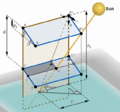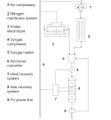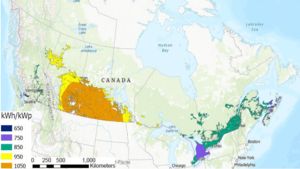
Canada has committed to reducing greenhouse gas (GHG) emissions by increasing the non-emitting share of electricity generation to 90% by 2030. As solar energy costs have plummeted, agrivoltaics (the co-development of solar photovoltaic (PV) systems and agriculture) provide an economic path to these goals. This study quantifies agrivoltaic potential in Canada by province using geographical information system analysis of agricultural areas and numerical simulations. The systems modeled would enable the conventional farming of field crops to continue (and potentially increase yield) by using bifacial PV for single-axis tracking and vertical system configurations. Between a quarter (vertical) and more than one third (single-axis tracking) of Canada’s electrical energy needs can be provided solely by agrivoltaics using only 1% of current agricultural lands. These results show that agrivoltaics could be a major contributor to sustainable electricity generation and provide Canada with the ability to render the power generation sector net zero/GHG emission free. It is clear that the potential of agrivoltaic-based solar energy production in Canada far outstrips current electric demand and can, thus, be used to electrify and decarbonize transportation and heating, expand economic opportunities by powering the burgeoning computing sector, and export green electricity to the U.S. to help eliminate their dependence on fossil fuels.
See also[edit | edit source]
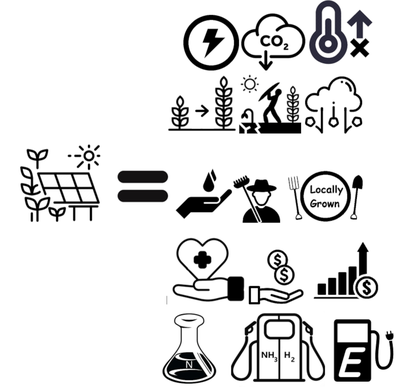
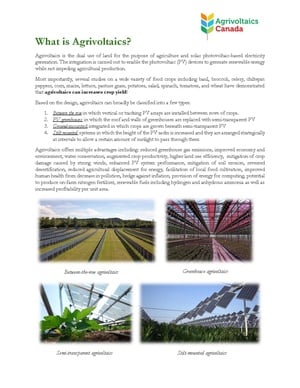
- Coal with Carbon Capture and Sequestration is not as Land Use Efficient as Solar Photovoltaic Technology for Climate Neutral Electricity Production
- Dual use of land for PV farms and agriculture literature review
- sheep
- Israeli white plastic reflectors
- A Farmer's Guide to Going Solar (NREL)
- German guidelines: https://www.ise.fraunhofer.de/content/dam/ise/en/documents/publications/studies/APV-Guideline.pdf
- 2021 review
- Miskin, C.K., Li, Y., Perna, A., Ellis, R.G., Grubbs, E.K., Bermel, P. and Agrawal, R., 2019. Sustainable co-production of food and solar power to relax land-use constraints. Nature Sustainability, 2(10), pp.972-980.
- Retrofitting solar parks for agrivoltaics
- Shading PV
- Alexis' talk at American Solar Grazing Association2021
In the News[edit source]
- Agrivoltaics: solar energy + better crops Climate and Nature
- Why solar power and farmers’ fields could be the perfect combination TVO
- Solar farms and sheep show the makings of a clean energy classic duo Business Renewables
- Agrivoltaics charge up St. Albert-area farms St Albert Gazette
- Sheep, solar and crops. How some Alberta farms are creating ideal growing conditions Western Wheel
- Sheep, solar and crops. How some Alberta farms create ideal growing conditions Voxpopuli
- 3D printed clamps for front-surface PV mounting on wood racking PV Magazine
- Harvesting the Sun to Grow in the Shade Garden Culture Magazine
- What crops fit with vertical agrivoltaics? PV Magazine
- Agrivoltaics – Keeping the farm in the solar farm Green Energy Futures
- Booming solar industry has a growing appetite for weed-chomping crews CBC
- La floreciente industria solar tiene un creciente apetito por equipos de devoradores de maleza Espanol news
- Des cochons à l’ombre des panneaux solaires, l’agrivoltaïsme gagne en popularité Radio Canada
- Pigs in the shade of solar panels, agrivoltaics gains popularity Euro Day France
- Des porcs à l’ombre des panneaux solaires, l’agrivoltaïque gagne en popularité News Day France
- ICI Radio
- The Weather Network
- Agrowoltaika zyskuje na wartości. Panele słoneczne na polu nie przekreślają upraw Business Insider Poland
- Kanada/ Coraz popularniejsza agrowoltaika: rolnictwo i produkcja energii w jednym Deon Pl
- Tu zboże, tam fotowoltaika. Rolnicy produkują i żywność i energię na jednym polu Bankier PL
- Kanada: coraz popularniejsza agrowoltaika: rolnictwo i produkcja energii w jednym MSN PL
- Agrowoltaika podbija świat (Agrovoltaics is conquering the world ) Warzywnichtow Polish
- Coraz popularniejsza agrowoltaika - rolnictwo i produkcja energii w jednym Agro Polska
- Agriculture and Energy Future - Agrivoltaics Agritecture
- MBA students examine a solar farm’s benefits for critical issues case competition Ivey
- Ontario solar curbs rankle expert BNN Bloomberg
- Solar
- Papers
- Agrivoltaics
- Solar power
- Solar energy
- Photovoltaics
- Sustainable development
- Agriculture
- SDG02 Zero hunger
- SDG07 Affordable and clean energy
- SDG08 Decent work and economic growth
- SDG09 Industry innovation and infrastructure
- SDG12 Responsible consumption and production
- 2023
- Canada
- Energy policy
- Farming
- Energy
- Land use
- FAST Completed






















